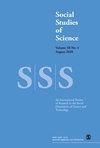诊断不明确:制作 "好 "的护理点检验,以消除全球卫生中的弊端
IF 2.7
2区 社会学
Q1 HISTORY & PHILOSOPHY OF SCIENCE
引用次数: 0
摘要
诊断测试有什么用?我们可能会认为这个问题的答案很简单。一个好的检验有助于确定某人患的是什么疾病,帮助医疗服务提供者确定正确的治疗方案,和/或使公共卫生当局能够了解和干预人口层面的健康问题。在这篇文章中,我们要说明的是,特定诊断检测的用途、它对不同参与者的价值,以及它是好还是不好,往往还远未定论。我们讲述了盘尾丝虫病(或称河盲症)快速抗体检测试剂盒的开发和设计故事,通过盘尾丝虫病疾病框架和全球健康创新生态系统重塑过程中的三个配置时刻,跟踪该试剂盒的多次迭代。建立诊断生态系统的努力往往以公共卫生对诊断的需求是预先给定且稳定的这一概念为前提;挑战在于如何激励投资并在资源不足的环境中为诊断找到客户群。相比之下,我们的研究表明,对于任何疾病而言,诊断需求都是多种多样且不断变化的,不太可能通过单一、独立的产品来满足。以盘尾丝虫病 Ov-16 快速检测为例,由于在创新过程中未能认识到并解决诊断需求的多重性和不稳定性,导致开发出的快速护理点检测产品可能会被生产、采购和使用,但却得不到公共卫生专家和商业制造商的青睐。我们认为,盘尾丝虫病快速检测的价值含糊不清,揭示了当前全球卫生创新生态系统在开发诊断 "商品 "方面的不足。本文章由计算机程序翻译,如有差异,请以英文原文为准。
Equivocal diagnostics: Making a ‘good’ point-of-care test for elimination in global health
What is a diagnostic test for? We might assume the answer to this question is straightforward. A good test would help identify what disease someone suffers from, assist health providers to determine the correct course of treatment and/or enable public health authorities to know and intervene in health at the level of the population. In this article, we show that what a specific diagnostic test is for, the value it holds for different actors, and what makes it good, or not, is often far from settled. We tell the story of the development and design of a rapid antibody test for onchocerciasis, or river blindness, tracking multiple iterations of the device through three configurational moments in the framing of onchocerciasis disease and reshaping of the global health innovation ecosystem. Efforts to build that ecosystem for diagnostics are often premised on the notion that public health needs for diagnostics are pre-given and stable; the challenge is seen to be how to incentivize investment and find a customer base for diagnostics in under-resourced settings. By contrast, we show that for any disease, diagnostic needs are both multiple and constantly in flux, and are unlikely to be met by a single, stand-alone product. In the case of the onchocerciasis Ov-16 rapid test, the failure to recognize and address the multiplicity and instability of diagnostic needs in the innovation process resulted in the development of a rapid point of care test that might be manufactured, procured and used, but is unloved by public health experts and commercial manufacturers alike. The equivocal value of the onchocerciasis rapid test, we suggest, reveals the inadequacy of the current global health innovation ecosystem for developing diagnostic ‘goods’.
求助全文
通过发布文献求助,成功后即可免费获取论文全文。
去求助
来源期刊

Social Studies of Science
管理科学-科学史与科学哲学
CiteScore
5.70
自引率
6.70%
发文量
45
审稿时长
>12 weeks
期刊介绍:
Social Studies of Science is an international peer reviewed journal that encourages submissions of original research on science, technology and medicine. The journal is multidisciplinary, publishing work from a range of fields including: political science, sociology, economics, history, philosophy, psychology social anthropology, legal and educational disciplines. This journal is a member of the Committee on Publication Ethics (COPE)
 求助内容:
求助内容: 应助结果提醒方式:
应助结果提醒方式:


